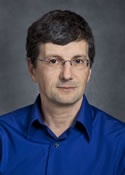When Jose Soriano, who does construction jobs in the Facilities Division, spotted a bottle of liquid near Building 88 without a label, his instincts kicked in. Uncertain whether the dark substance in the bottle was safe or whether it had been illegally dumped, he stopped shoveling and alerted his supervisor. Jose was concerned that the bottle’s contents could be toxic to the environment or to fellow workers.
“It’s what they teach us,” says Jose, “to make safety the first concern.”
Jose thought first of his coworkers’ safety. But he’s also careful about the environmental dangers possible in such a situation. “Nature is my first call,” he says. “What we do affects everyone.”
Photo by Roy Kaltschmidt
Jose performs construction jobs for Berkeley Lab, including trenching, operating a backhoe, and working with concrete. In his 13 years at the Lab, his safety awareness has only increased, he says.
The substance in the bottle was analyzed, found to be a hazardous oil, and disposed of properly. For his attention to safety, Jose was handed a Hero Card. Hero Cards are an easy way to say “good job” for performing positive everyday safe behavior.
Jose registered the card on the Hero Card website which automatically entered him in a quarterly raffle drawing. His was the lucky number pulled, and Jose is $50 richer. The other quarterly raffle winner, Frank Rosado, received a Hero Card for helping a coworker in Building 50 rid a cubicle of a mouse.
Such seemingly simple acts reveal a concern for the safety of others that goes above and beyond a job description. If you know someone who has shown such concern for others, thank them with a Hero Card! If you need a supply of cards, e-mail mrruggieri@lbl.gov. If you want to learn more about the Hero Card Program, go to the Hero Card website.
For ATAP Division Director Wim Leemans, listening to firsthand accounts of accidents and near-misses “is more powerful than any lessons learned that you get in an e-mail.”
For example, he says, two of his Lab workers shared experiences from previous jobs in industry, where, Leemans says, “laser safety standards were lower than what we have.” Both employees had suffered eye injuries from lasers. Among their details shared with Berkeley Lab coworkers: When you are struck in the eye with a laser, your vision turns red due to popped blood vessels.
“You think it will happen to somebody else, never to anyone you know,” says Leemans. “But when you hear it from someone who actually went through it, it’s very powerful.”Fortunately, ATAP has an excellent safety record with lasers. “That didn’t come by itself,” says Leemans. “It was by working closely with the laser safety officers, in addition to the deep-rooted safety culture of the folks who use the lasers. We have a strict policy on wearing goggles, which took a lot of education, and that’s where those personal stories come in.” Wearing goggles can be inconvenient at times, but the stories underscored the importance by providing concrete examples—and making it personal.
Regarding lasers and other hazards, Leemans encourages his staff to share their experiences without fear of judgment or being called clumsy or inattentive. “It takes courage to say, ‘I made a mistake and I don’t want anyone else to do that.’”
A culture that rewards openness, feedback, and the perseverance to dig down for root causes and think about how to generalize solutions can have benefits beyond Berkeley Lab. Once, an Engineering Division worker in ATAP (then called AFRD) suffered a cut to the head while working with a machine. The machining station had been quiet for a minute or more, and when the worker reached inside the machine to clean it, it suddenly kicked back into gear to change a tool, striking the worker in the head. The two divisions mobilized. “In our safety culture, everyone immediately went to work to find the most robust, engineered way to avoid this happening again,” Leemans says. They worked with the vendor to find a solution. As a result, the manufacturer recommended an interlock system to solve this problem.
“It’s something the Lab as a whole can be proud of, that we have worked with and influenced vendors” by giving feedback on machine operation, says Leemans. “I’m very proud of the way it was handled.”
Besides lasers and machines with moving parts, Leemans’ division also works with radiation sources. When the group wanted to turn a laser beam into an electron beam by shooting it into a plasma, resulting in accelerated charged particles, they turned to the Lab’s Radiation Safety Committee and Radiation Protection Group first. “We told them, ‘We need your help on thinking through how we go from that concept to something we can execute safely,’” Leemans says. Not only were the groups involved in planning, but “they were with us from the first time we produced electrons from the laser beam, on that very night. My approach has always been to bring them in on the ground floor, not when you’re already well-launched in your project. It’s a partnership, with the understanding that if we make a mistake, they can call us on it.”
While Leemans takes pride in his division’s — and the Lab’s — focus on safety, he acknowledges that the job is never done. “You can’t just stop reinforcing safety culture because you feel content or you think everyone understands it,” he says. Each year brings a fresh crop of students and staff. “You must relay those important lessons to the incoming generation.”

